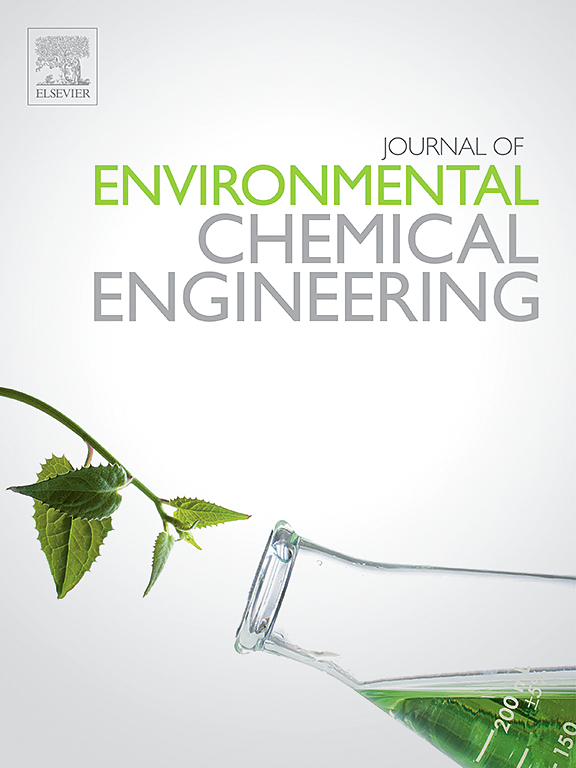硫酸钠氨碱法纯碱生产废水综合利用新战略
IF 7.4
2区 工程技术
Q1 ENGINEERING, CHEMICAL
引用次数: 0
摘要
利用二氧化碳和氨水制取硫酸钠的氨碱法生产纯碱是实现硫酸钠废弃资源综合利用的有效方法,但该方法会产生大量以碳酸氢钠和硫酸铵为主要物质的废水,限制了硫酸钠法氨碱法(SSA-Process)生产纯碱的模块化工业应用。目前,硫酸钠法生产纯碱废水的主要利用方法是采用蒸发结晶法处理副产物硫酸钠和硫酸铵,该方法价值低、工艺复杂、能耗高,因此迫切需要一种低成本、高价值、短流程的方法来综合利用硫酸钠法生产纯碱废水。本研究基于氢氧化钙(Ca(OH)2)在传统氨碱法工艺中的应用理论,系统研究了氢氧化钙(Ca(OH)2)在 SSA 法生产纯碱模拟废水中的苛化规律和机理。在此基础上,开发了 Ca(OH)2 分段苛化新工艺,以实现 SSA 工艺生产纯碱废水的综合利用。研究结果表明,该工艺可实现高效氨循环,从而降低成本,并生产出高纯度的超细碳酸钙产品和固体硫酸钠,以及用于建筑材料的钙基原料。本文章由计算机程序翻译,如有差异,请以英文原文为准。
A new strategy for the comprehensive utilization of wastewater from the production of soda ash by sodium sulfate-based ammonia-soda process
The production of soda ash by the ammonia-soda process using carbon dioxide and ammonia for sodium sulfate is an effective method to realize the comprehensive utilization of waste resources of sodium sulfate, but this method produces a large amount of wastewater whose main substances are sodium bicarbonate and ammonium sulfate, which limits the modular industrial application of the production of soda ash by sodium sulfate-based ammonia-soda process(SSA-Process). At present, the main utilization method for the wastewater from the production of soda ash by SSA-Process is evaporation crystallization method to deal with the by-products of sodium sulfate and ammonium sulfate, which is a low-value, complex and energy-consuming process, so is an urgent need for a low-cost, high-value, short-process method to comprehensively utilize wastewater from the production of soda ash by SSA-Process. Based on the application theory of calcium hydroxide (Ca(OH)2) in the traditional ammonia-soda process, this present study systematically investigated the causticization law and mechanism of Ca(OH)2 in a simulated wastewater from the production of soda ash by SSA-Process. On this basis, a new process of Ca(OH)2 segmented causticization was developed to realize the comprehensive utilization of wastewater from production of soda ash by SSA-Process. The results showed that this process enabled a highly efficient ammonia cycle for cost reduction and the production of high purity ultrafine calcium carbonate products and sodium sulfate solids, as well as calcium-based raw material for building materials.
求助全文
通过发布文献求助,成功后即可免费获取论文全文。
去求助
来源期刊

Journal of Environmental Chemical Engineering
Environmental Science-Pollution
CiteScore
11.40
自引率
6.50%
发文量
2017
审稿时长
27 days
期刊介绍:
The Journal of Environmental Chemical Engineering (JECE) serves as a platform for the dissemination of original and innovative research focusing on the advancement of environmentally-friendly, sustainable technologies. JECE emphasizes the transition towards a carbon-neutral circular economy and a self-sufficient bio-based economy. Topics covered include soil, water, wastewater, and air decontamination; pollution monitoring, prevention, and control; advanced analytics, sensors, impact and risk assessment methodologies in environmental chemical engineering; resource recovery (water, nutrients, materials, energy); industrial ecology; valorization of waste streams; waste management (including e-waste); climate-water-energy-food nexus; novel materials for environmental, chemical, and energy applications; sustainability and environmental safety; water digitalization, water data science, and machine learning; process integration and intensification; recent developments in green chemistry for synthesis, catalysis, and energy; and original research on contaminants of emerging concern, persistent chemicals, and priority substances, including microplastics, nanoplastics, nanomaterials, micropollutants, antimicrobial resistance genes, and emerging pathogens (viruses, bacteria, parasites) of environmental significance.
 求助内容:
求助内容: 应助结果提醒方式:
应助结果提醒方式:


